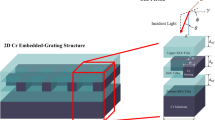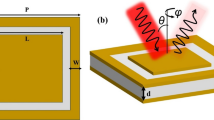Abstract
In recent years, significant strides have been made in the inverse design of metamaterial perfect absorbers (MPAs) using deep learning techniques. However, this progress has been hindered by the functional homogeneity arising from the structural uniformity of the inverse-designed MPAs. In this paper, we address this limitation by designing reconfigurable MPAs (RMPAs) with three distinct structures and propose a residual parallel neural network (RPNN) that incorporates the optimized residual fully connected neural network (RFC-NN) for the inverse design of multifunctional MPAs. The trained RPNN accurately predicts the structural parameters and their corresponding absorption spectra with remarkable precision, yielding R2 values of 0.9981 and 0.9928, respectively. With this model, we successfully inverted the design of MPAs with three functions: broadband absorption, dual-band absorption, and triple-band absorption properties. A particularly noteworthy achievement was the realization of absorption bandwidth shifts using liquid crystal (LC) materials. Our RPNN showcases its proficiency in designing RMPAs with multifunctionality, all within a single network model. This marks a significant advancement over previous research methodologies. The proposed methodology holds great promise in diverse applications such as solar energy harvesting, detection, and filtration.











Similar content being viewed by others

Availability of Data and Materials
The data will be made available on a reasonable request to the corresponding author.
References
Landy NI, Sajuyigbe S, Mock JJ (2008) A perfect metamaterial absorber. Phys Rev Lett 100:20–23
Iwaszczuk K, Strikwerda AC, Fan K, Zhang X, Averitt RD, Jepsen PU (2012) Flexible metamaterial absorbers for stealth applications at terahertz frequencies. Opt Express 20(1):635–643
Wang H, Wang L (2013) Perfect selective metamaterial solar absorbers. Opt Express 21(S6):A1078–A1093
Carranza IE, Grant JP, Gough J, Cumming D (2017) Terahertz metamaterial absorbers implemented in CMOS technology for imaging applications: scaling to large format focal plane arrays. IEEE J Sel Top Quantum Electron 23:4700508
Geng Z, Su W, Wang XY, Jiang YF, Liu Y (2019) Numerical design of a metasurface-based ultra-narrow band terahertz perfect absorber with high Q-factors. Optik 10:163071
Majid A, Farzad T, Negin S, Justin L, Mehran A (2020) Wide-angle metamaterial absorber with highly insensitive absorption for TE and TM modes. Sci Rep 10:13638
Abdulkarim YI, Awl HN, Alkurt FO, Muhammadsharif FF, Saeed SR, Karaaslan M, Bakır M, Luo H (2021) A thermally stable and polarization insensitive square-shaped water metamaterial with ultra-broadband absorption. J Mater Res Technol 13:1150–1158
Zhang M, Zhang F, Ou Y, Cai J, Yu H (2019) Broadband terahertz absorber based on dispersion-engineered catenary coupling in dual metasurface. Nanophotonics 8:117–125
Xiong H, Yang Q, Huang Z, Zhang H (2021) Analyzing broadband tunable metamaterial absorber by using symmetry model. Opt Express 29:41475–41484
Sun C, Liu H, Yang B, Zhang K, Zhang B, Wu X (2023) An ultra-broadband and wide-angle absorber based on a TiN metamaterial for solar harvesting. Phys Chem Chem Phys 25:806–812
Weng X, Wang J, Xu C, Wang Y, Liao Y, Wang J (2023) Dual-band perfect absorber based on all-dielectric GaAs metasurface for terahertz wave. Plasmonics 18:521–528
Yao G, Ling F, Yue J, Luo CY, Ji J, Yao JQ (2016) Dual-band tunable perfect metamaterial absorber in the THz range. Opt Express 24:1518–1527
Wang J, Yang R, Tian J, Chen X, Zhang W (2018) A dual-band absorber with wide-angle and polarization insensitivity. IEEE Antenn Wirel PR 17:1242–1246
Pouria Z, Pejman R (2021) A terahertz dual-band metamaterial perfect absorber based on metal-dielectric-metal multi-layer columns. Opt Quantum Electron 53:109
Cen C, Zhang Y, Chen X (2020) A dual-band metamaterial absorber for graphene surface plasmon resonance at terahertz frequency. Phys E 117:113840
Wang RX, Li L, Liu JL, Yan F, Tian FJ, Tian H, Zhang JZ, Sun WM (2017) Triple-band tunable perfect terahertz metamaterial absorber with liquid crystal. Opt Express 25:32280–32289
Cheng YZ, Zhao JC (2022) Simple design of a six-band terahertz perfect metasurface absorber based on a single resonator structure. Phys Scr 97(9):095508
Wang XY, Wang QM, Dong GY, Hao YN, Lei M, Bi K (2017) Multi-band terahertz metasurface absorber. Mod Phys Lett B 31:1750354
Chen ZH, Chen H, Huge J, Xu DY, Yi L, Chen XF, Zhou ZG, Cai SS, Li GF (2021) Multi-band multi-tunable perfect plasmon absorber based on L-shaped and double-elliptical graphene stacks. Diam Relat Mater 115:108374
Wang YQ, Yi YT, Xu DY, Yi Z, Li ZY, Chen XF, Jile H, Zhang JG, Zeng LC, Li GF (2021) Terahertz tunable three band narrowband perfect absorber based on Dirac semimetal. Physica E 131:114750
Zhang Y, Li J, Chou J, Fang Z, Yadav A, Lin H, Du Q, Michon J, Han Z, Huang Y, Zheng H (2017) Broadband transparent optical phase change materials. CLEO: Science and Innovations 2017:14–19
Zhang PS, Deng XH, Tao LY, Li P, Lu M, Guo FM, Song YM, Yuan JR (2023) Broadband actively tunable metamaterial absorber based on vanadium dioxide and Fabry-Perot cavity. Opt Mater 138:113716
Yin S, Dong X, Liu JX, Ke L, He HL, Jiang SZ, Dan L, Sun XW, Wei J, Liu YJ (2018) Reconfigurable chiral metasurface absorbers based on liquid crystals. IEEE Photonics J 10(6):1–9
Esteva A, Kuprel B, Novoa RA, Ko J, Swetter SM, Blau HM, Thrun S (2017) Dermatologist-level classification of skin cancer with deep neural networks. Nature 542(7639):115–118
Liu J, Dou C, Chen W, Ma WZ, Meng D, You XQ, Chen YS, Huang PH, Gu Y (2022) Inverse design a patternless solar energy absorber for maximizing absorption. Sol Energy Mater Sol Cells 244:111822
Chen W, Gao Y, Li Y, Yan Y, Ou JY, Ma W, Zhu J (2023) Broadband solar metamaterial absorbers empowered by transformer-based deep learning. Adv Sci 10(13):2206718
Ma J, Huang YJ, Pu MB, Xu D, Luo J, Guo YH, Luo XG (2020) Inverse design of broadband metasurface absorber based on convolutional autoencoder network and inverse design network. J Phys D Appl Phys 53:464002
Li Z, Xu J, Zhang L, Li Y, Yang R, Fu Q, Zhang F, Fan Y (2023) Inverse design of dual-band optically transparent metasurface absorbers with neural-adjoint method. Annalen der Physik 535(6):2300054
Wang S, Yuan X, Gu L, Xie S, Ma Q, Wei Z, Guo J (2023) Innovative design of metamaterial perfect absorbers via residual fully connected neural network modeling. Opt Commun 545(15):129732
Li J, Wu ST, Brugioni S, Meucci R, Faetti S (2005) Infrared refractive indices of liquid crystals. J Appl Phys 97:073501
Funding
This work has been supported by National Natural Science Foundation of China (Grant Nos. 62175070 and 61875057); GuangDong Basic and Applied Basic Research Foundation (Grant No. 2021A1515010352, No. 2021A1515012652, No. 2023A1515012966); and The Science and Technology Program of Guangzhou (Grant No. 202201010340).
Author information
Authors and Affiliations
Contributions
Shuqin Wang, Zhongchao Wei, Ruihuan Wu, Qiongxiong Ma, Jianping Guo, and Wen Ding contributed to the study conception and design. Material preparation, data collection, and analysis were performed by Shuqin Wang. Shuqin Wang wrote the main manuscript text, while Shuqin Wang, Zhongchao Wei, Ruihuan Wu, Qiongxiong Ma, and Jianping Guo prepared Figs. 1–8, 10, and 11. Shuqin Wang and Wen Ding prepared Fig. 9. Data acquisition was performed by Shuqin Wang, Zhongchao Wei, Jianping Guo, and Wen Ding. Jianping Guo supervised the project. The investigation and software were performed by Shuqin Wang, Zhongchao Wei, Wen Ding, and Jianping Guo. Funding acquisition was provided by Zhongchao Wei, Ruihuan Wu, and Qiongxiong Ma. All authors reviewed the manuscript.
Corresponding author
Ethics declarations
Ethics Approval
This is an observational study. The XYZ Research Ethics Committee has confirmed that no ethical approval is required.
Consent to Participate
Informed consent was obtained from all individual participants included in the study.
Consent for Publication
The authors affirm that human research participants provided informed consent for publication of the images in figure.
Conflict of Interest
The authors declare no competing interests.
Additional information
Publisher's Note
Springer Nature remains neutral with regard to jurisdictional claims in published maps and institutional affiliations.
Supplementary Information
Below is the link to the electronic supplementary material.
Rights and permissions
Springer Nature or its licensor (e.g. a society or other partner) holds exclusive rights to this article under a publishing agreement with the author(s) or other rightsholder(s); author self-archiving of the accepted manuscript version of this article is solely governed by the terms of such publishing agreement and applicable law.
About this article
Cite this article
Wang, S., Wei, Z., Wu, R. et al. Residual Parallel Neural Networks Aided Inverse Design for Multifunctional Reconfigurable Metamaterial Perfect Absorbers. Plasmonics (2023). https://doi.org/10.1007/s11468-023-02133-z
Received:
Accepted:
Published:
DOI: https://doi.org/10.1007/s11468-023-02133-z



